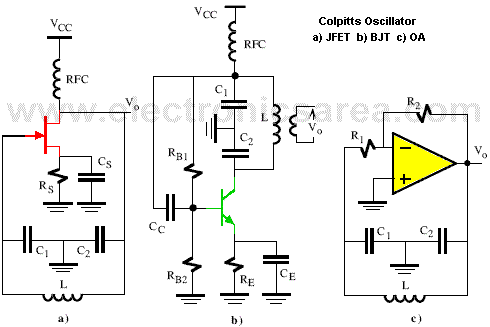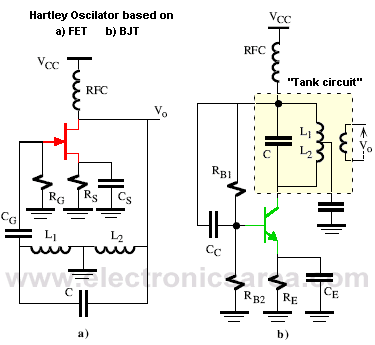LC oscillator: Inductance – Capacitance Oscillator
A simple oscillator can be built with an amplifier stage and an inductive-capacitive network (LC) to provide an offset of -180°. The oscillation frequency can be freely adjusted or tuned on a range of frequencies from 100kHz to a few hundred MHz by changing only the value of C or L.
These LC tuned oscillators are used in a variety of applications including radio transmitters, AM and FM, receivers and sine wave generators. The more known LC oscillators are:
- Colpitts oscillator
- Hartley oscillator.
Their difference lies in the feedback network: the Colpitts oscillator uses a capacitive divider in parallel with an inductance and the Hartley oscillator uses an inductive divider in parallel with a capacitance.
On the above diagram there are three possible configurations of the Colpitts oscillator based on FETs, BJTs, and on OA (Operational Amplifier), although this is often not used because of its limitation in frequency.
The RFC self-induction serves to isolate the power line of the oscillator, i.e., its value is high enough to prevent the sinusoidal signal to be transmitted to the power source.
If the frequency of oscillation (ƒo) is low enough to consider negligible the internal capacitive effects of transistors and the OA, and if the inductance L has negligible internal resistance, then the frequency of oscillation is determined by the LC network (also known in many cases with the name of “tank circuit” because it behaves as energy reservoir storage). For the Colpitts oscillator, this frequency is:
This relationship must be combined with the amplifier stage gain to ensure the conditions of oscillation.
Similarly, the oscillation frequency of the Hartley oscillator shown in the figure above is given by:
Note: L = Inductor (inductance), C = Capacitor (capacitance).
You may be interested in:
- Sinusoidal oscillator (basic structure)
- Sinusoidal oscillators – Basic principles
- UJT Relaxation oscillator circuit
- Crystal Oscillators – Piezoelectric Oscillator. Equivalente circuit
- LC Oscillator – Inductance – Capacitance Oscillator
- Phase Shift Oscillator
- Wien-bridge Oscillator with Op Amp
- Nonlinear Amplitude Control of a Sinusoidal Oscillator








